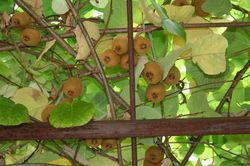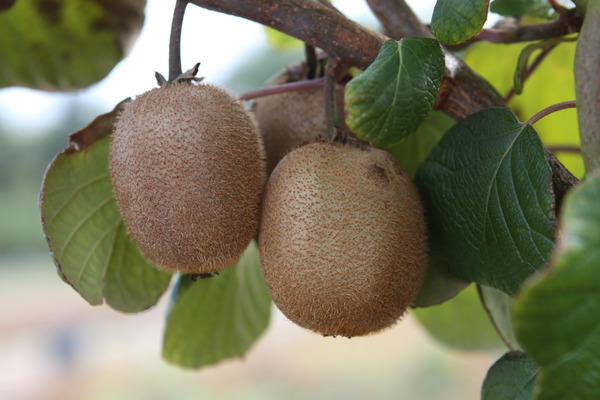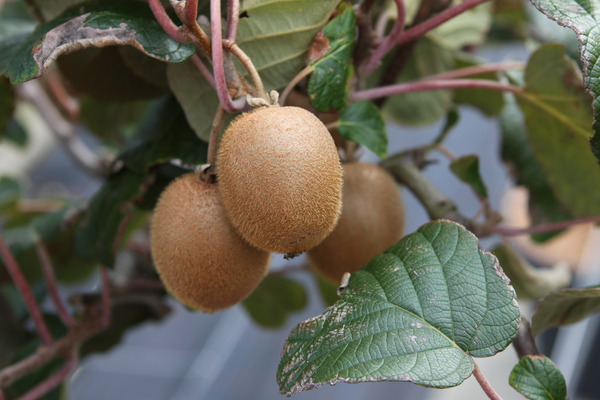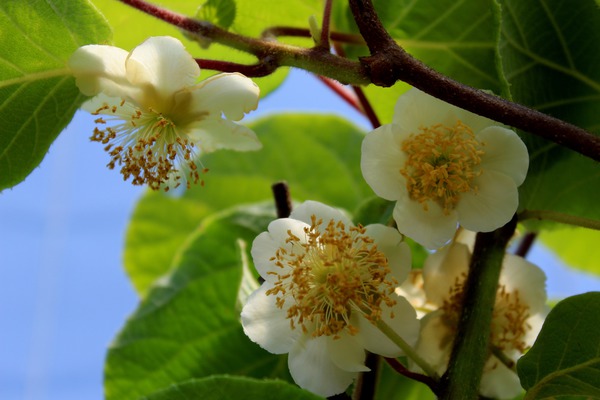 As a fruit, the kiwi – here we mean the large-fruited fuzzy kiwi Actinidia deliciosa – has a comparatively short history in Europe. It was not until the 1950s, for example, that the first kiwi fruit was imported into Britain. The country of origin, how could it be otherwise, was then and still is New Zealand. Today, it is hard to imagine a fruit shop or supermarket without kiwis and they are available year-round. Varieties that used to be found exclusively growing in plantations are now also available as plants for your own garden. However, there are also newer varieties that produce regular yields in Central Europe and enrich (almost) every garden. We would like to introduce you to these varieties in the following text.
As a fruit, the kiwi – here we mean the large-fruited fuzzy kiwi Actinidia deliciosa – has a comparatively short history in Europe. It was not until the 1950s, for example, that the first kiwi fruit was imported into Britain. The country of origin, how could it be otherwise, was then and still is New Zealand. Today, it is hard to imagine a fruit shop or supermarket without kiwis and they are available year-round. Varieties that used to be found exclusively growing in plantations are now also available as plants for your own garden. However, there are also newer varieties that produce regular yields in Central Europe and enrich (almost) every garden. We would like to introduce you to these varieties in the following text.
Kiwi young plants – a short excursion into botany
Before we get into the descriptions of the varieties, we will first take a brief look at the botany of the kiwi fruit and how the fruit got its name.
The name
The name 'kiwi' for the fruits of the plant Actinidia deliciosa goes back to New Zealand marketing experts. At the beginning of the 20th century, the first kiwi fruits arrived in New Zealand and only half a century later, New Zealand was the largest grower and exporter of kiwis, behind the country of origin, China. Due to this popularity, marketing experts in New Zealand came up with the idea to name this fruit after the kiwi, the national bird of the country.
Prior to this more than successful marketing campaign, both the plant and its fruit were known as the Chinese gooseberry.
Origin
As already mentioned, the large-fruited kiwi (Actinidia deliciosa) originates from China. There, the original distribution area is in the south-western highlands and the area surrounding the Yangtze River. Kiwi trees can be found there up to 1900 meters above sea level.
Description
Kiwi plants are deciduous climbers with a liana-like growth habit. The annual shoots can easily reach a length of four metres and more. Depending on the location in Europe, the plants sprout at the end of April to the beginning of May, making them particularly susceptible to late frosts.
Pollination
Basically, kiwi plants are dioecious and you need both a female plant and a male plant as pollinators to be able to harvest fruit. But here too, exceptions prove the rule. There are varieties that are marketed as self-fertile but are much more likely to be parthenocarpic, i.e. to set fruit even without fertilisation. Identifying the sex of a kiwi plant is only possible during the flowering period; the sex cannot be determined on the basis of the growth or the leaves.
Winter hardiness
In principle, plants of the large-fruited kiwi are sufficiently winter hardy in Central Europe. However, there are differences between the varieties. The special thing about the winter hardiness of Actinidia deliciosa is that not all parts of the plant can cope with equally low temperatures.
Well-established plants can withstand winter temperatures below -20°C. This does little harm to the plant itself, which sprouts again in the spring. However, such a plant will not flower the following spring, as the inflorescences in the buds can only survive winter temperatures down to a maximum of -18°C. At lower temperatures, the inflorescences freeze, but the bud itself is not further damaged and sprouts again without developing flowers.
Kiwi young plants – 'self-fertile' fuzzy kiwi varieties
As with kiwi berries, there are also large-fruited kiwis plants that produce fruit without cross-pollination. Such varieties are commonly referred to as self-fertile, which is probably not quite correct botanically. It is much more likely that these plants/varieties are parthenocarpic or 'virgin-fruited', which comes from the Greek parthenos virgin + karpos fruit. In other words, they produce fruit even without fertilisation. These can be both female and male plants/varieties.
These varieties have the advantage that only one plant is needed to be able to harvest fruits. However, the fruits are much smaller in proportion and the plants usually produce fewer fruits.
Kiwi 'Jenny'
The kiwi 'Jenny' is basically a male plant, but it is able to produce fruit through parthenocarpy. It is therefore classified as a so-called self-fruiting kiwi. This is accompanied by the fact that parthenocarpic fruits usually remain smaller. The kiwi 'Jenny' was developed in Germany and it is said that this variety tolerates lower temperatures than other varieties.

Picture: self-fertile fuzzy kiwi 'Jenny'
Advantages of the kiwi 'Jenny':
- Forms parthenocarpic fruits
- Ideal for limited space conditions
- An additional variety increases the yield
Short description of the kiwi 'Jenny':
Growth: A strong-growing climbing plant, summer pruning is essential
Ripening/harvest: Harvest from October to early November – at the latest after the first frost; eating ripeness depends on the storage temperature, can be accelerated by storing with an apple in a plastic bag
Fruits: Small, greenish brown, hairy fruits
Taste: Sweet-sourish, typical kiwi flavour
Kiwi 'Solissimo®' (renactPBR)
The kiwi 'Solissimo®' (renactPBR) is the first 'self-fertile' kiwi variety that produces regular and reliable yields. The fruit size of the variety descending from 'Hayward' has also been significantly improved. Like the other classic kiwis, 'Solissimo' (renactPBR) is very vigorous; it grows 4-7 m tall and needs a robust climbing frame. In the first years of cultivation, light winter protection is recommended. Once established, the kiwi 'Solissimo' (renactPBR) also forms metre-long shoots in the summer. Summer pruning in June or July is therefore not recommended, but obligatory for this variety too. This measure promotes flowering in the following year and, in contrast to winter pruning, tends to inhibit growth, which can increase the yield and harvest volume.

Picture: self-fertile fuzzy kiwi 'Solissimo®' (renactPBR)
Advantages of the kiwi 'Solissimo®' (renactPBR):
- Forms parthenocarpic fruits
- Ideal for limited space conditions
- Reliable yields
Short description of the kiwi 'Solissimo®' (renactPBR):
Growth: A strong-growing climbing plant, summer pruning is mandatory
Ripening/harvest: Harvest from October to early November – at the latest after the first frost; eating ripeness depends on the storage temperature, can be accelerated by storing with an apple in a plastic bag
Fruits: Medium-sized, roundish, greenish brown, hairy fruits
Taste: Juicy sweet with a distinct but pleasant acidity
Kiwi young plants – female fuzzy kiwi, high-yielding varieties
The variety group of female kiwi plants is characterised by the highest and regular yields. However, to achieve these yields, a male pollinator variety is essential.
Kiwi 'Kivite®'
The female fuzzy kiwi 'Kivite®' is one of our novelties this year and a real garden kiwi. Freshly planted plants quickly start to yield and convince with their joy of flowering and extremely reliable, regular yields. Kivite® bears more and also more regular fruit than the better known 'Hayward'. The medium-sized fruits are brownish-haired and have an inverted egg shape. With an average weight of about 50g, the fruits are smaller than those of 'Hayward', but the number of fruits on the plants of 'Kivite®' is much higher. The wood is relatively resistant to winter frosts, but the shoots in spring must be protected from late frosts.

Picture: female fuzzy kiw 'Kivite®'
Advantages of the kiwi 'Kivite®':
- the reliable garden kiwi
- bears much more regular and more fruit than Hayward
- comes into yield quickly
Short description of the kiwi 'Kivite®':
Growth: A strong-growing climbing plant, summer pruning is essential
Ripening/harvest: Harvest from October to early November – at the latest after the first frost; eating ripeness depends on the storage temperature, can be accelerated by storing with an apple in a plastic bag
Fruits: Medium-sized and brown-haired fruit, inverted-egg shaped, on average about 50 g in weight
Taste: Pleasantly juicy with a good sweetness and a distinct acidity – a typical kiwi flavour...
Kiwi 'Hayward'
The fuzzy kiwi 'Hayward' is the standard female variety among the fuzzy kiwis. Provided it is pollinated, the variety produces large fruits and high yields. The fruits are typically slightly cylindrical, which can be seen particularly well in cross-section. The flesh is light green, juicy and tastes sweet and sour. As a very strong and spreading climber, the female kiwi 'Hayward', like all kiwis, needs a sturdy climbing support, which should not be too tight. Planting is actually only recommended for the best locations. Light winter protection is recommended for the first 2-3 years. As with all other kiwi varieties, summer pruning (June-July) is essential. This involves shortening the long, sometimes massively sprawling, one-year-old shoots down to a few eyes. Summer pruning is important for flowering in the following year and reduces growth.

Picture: female fuzzy kiwi 'Hayward'
Advantages of the kiwi 'Hayward':
- the standard variety
- well-known classic
- suitable for best locations
Short description of the kiwi 'Hayward':
Growth: A strong-growing climbing plant, summer pruning is essential
Ripening/harvest: Harvest from October to the beginning of November – at the latest after the first frost; eating ripeness depends on the storage temperature, can be accelerated by storing with an apple in a plastic bag
Fruits: Large, green-brown hairy, slightly cylindrical fruits
Taste: Juicy, sweet and sourish
Kiwi young plants – male fuzzy kiwi - the pollinator varieties
Without a male kiwi variety to act as a pollinator for the female kiwi varieties, there will be no yield. Therefore, it is essential to plant at least one male kiwi plant. It is important that the flowering period of the female and male varieties match.
Here is a fun fact on the side: female kiwi berry varieties can also be fertilised by a male Actinidia deliciosa plant. This is unlikely to occur naturally in the garden due to the different flowering times of the mini kiwi and large-fruited kiwi.
Kiwi 'Tomuri'
The male kiwi variety 'Tomuri' is a reliable pollinator for female kiwis (Actinidia deliciosa). The flowers are cream-coloured and appear in June. One plant is sufficient to pollinate several female kiwis, provided the pollinator produces enough flowers and is only a few metres away from the female plants. The male kiwi 'Tomuri' is also a strong grower and summer pruning is mandatory. If only one female plant needs to be pollinated, the male plant can be grown much smaller by rigorous pruning. The male kiwi 'Tomuri' also promotes higher yields and larger fruits in 'self-fertile' varieties.

Picture: fuzzy kiwi' Tomuri' - Pollinator variety for the female fuzzy kiwi varieties, one no longer recognises a pistil and sees only the predominant male stamens and anthers
Advantages of the kiwi 'Tomuri':
- A male pollinator for kiwis
- Blooms richly and reliably
- Healthy and vital
Short description of the kiwi 'Tomuri':
Growth: A strong-growing climber, summer pruning is essential
Fruits: A male pollinator variety, no fruit set
Golden fuzzy kiwi young plants
In addition to the green, large-fruited kiwis, there are always those with yellow flesh and with a clearly less hairy fruit skin on the market. These are usually varieties of the green kiwifruit Actinidia deliciosa var. chinensis. Depending on the literature, however, this classification is not generally valid. Sometimes A. chinensis is listed as a separate species and sometimes A. deliciosa is considered a variety of A. chinensis.
Nevertheless, the yellow-fruited large kiwis are a separate group of varieties on which we are currently working and where we hope to expand our range of large-fruited kiwis in the medium term.
